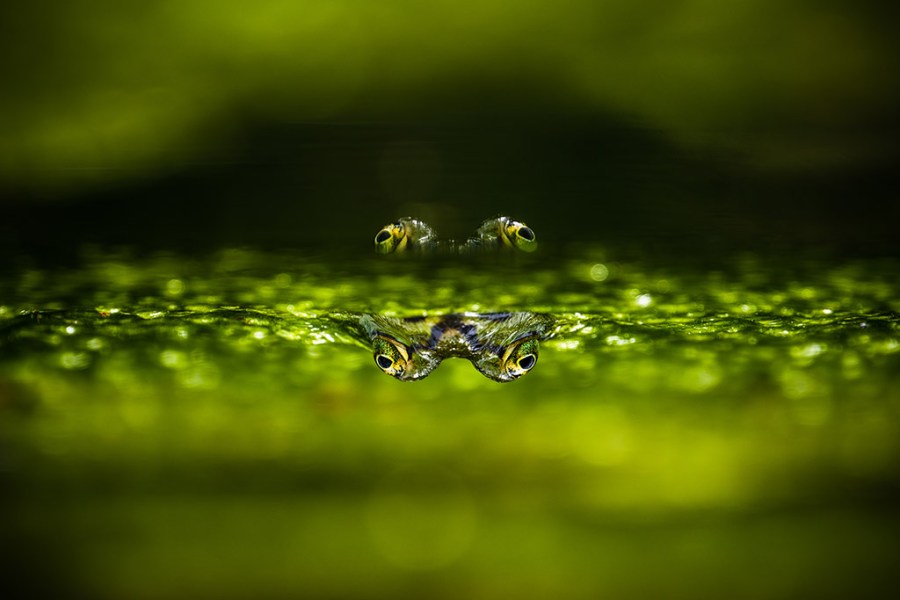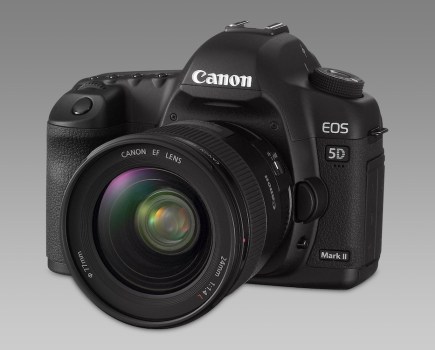The results of the CUPOTY Challenge: Water competition, are in and everything from mating toads to frozen flowers have been put before the judges. Selected entrants share their tips with CUPOTY co-founder Tracy Calder.
Apparently, every second breath we take comes from the ocean. It’s a sobering statistic, and one that makes caring for our oceans and waterways absolutely vital. Photographers have an important role to play in alerting us to the state of the natural world, and one way of doing this is to celebrate what we stand to lose if we continue to treat our oceans and rivers as waste receptacles. A few weeks ago, I got chatting to two underwater photographers. We discussed the impact of climate change, sewage and other pollutants on wildlife, but we also talked about the sheer wonder of discovering something new and the absolute joy of being submerged in water. I was struck by their calm, relaxed demeanour – being in or around bodies of water is said to have a soothing effect on the human brain and these two certainly seemed to back up the science!
Environmental and health benefits aside, water (in all its forms) can be fascinating to photograph – everything from reflections to raging rivers and sheets of ice can enhance a picture or even become the subject of an image. For the latest CUPOTY CHALLENGE (in association with Affinity Photo 2) our subscribers chose water as the theme. Our callout was answered with images of seahorses swimming through kelp, flowers bejeweled with rain, and insects drying out their wings before taking flight, among other things. As usual, looking at all the entries was both educational and inspiring.
Congratulations to Tibor Litauszki for taking the top spot with his beautiful image of an alpine newt.
If you would like to stay up to date with the latest CUPOTY news, including details of this year’s main competition and how you can enter your macro photography, please sign up to the CUPOTY newsletter. To see all of the shortlisted entries for the CUPOTY CHALLENGE: Water, please visit www.cupoty.com/water-shortlist
CUPOTY Water Challenge Overall Winner: Tibor Litauszki, Between the Stars
Nationality: Hungarian
Instagram: @tiborlitauszki_naturphtgrphy
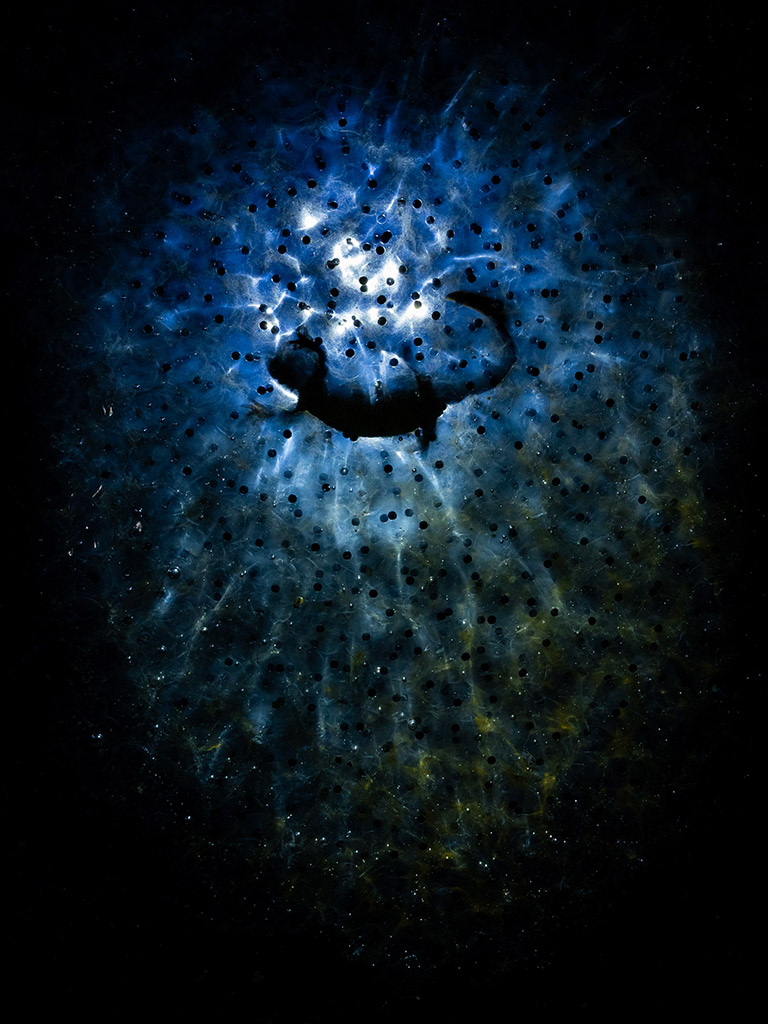
‘In Germany, where I live, there are many clear and slow-flowing streams that provide excellent habitat for alpine newts. I have been following their lives for years, and last year was no exception. A few days after the frogs lay their eggs, at dusk, the newts appear and feast on the spawn all through the night. I wanted to capture this moment underwater.
To do this, I placed my camera in an underwater housing, attached it with weights, and placed it under the frogs’ eggs. I was a bit nervous at first because I wasn’t sure if the underwater housing was completely waterproof. But I figured that if no bubbles appeared, my camera would stay dry. I manually set the focus on the lens beforehand and hoped to get lucky. Waiting nearby until it got dark, I illuminated the first newt that appeared with an LED light and triggered the camera with a homemade wired remote release.’
Top tips:
- Go out into nature as often as possible. Pay attention to everything – the smallest detail or moment can lead to a successful picture.
- Think about using artificial light sources. Here I used an LED to illuminate the scene.
- When you study nature closely, the attention you pay (and the images you create) can play a part in conservation.
CUPOTY Water Challenge 2nd Place: Ian Gilmour, Poppies Tiarella in Ice
Nationality: British
Occupation: Retired
Website: www.iangilmour.co.uk
Facebook: IanGilmourPhotography

‘I submerged some wild poppies in water with tiarella flowers and froze them overnight. I then placed the frozen block on a lightbox and photographed them using my Venus Laowa super macro lens. My first attempt was unsuccessful as the water was cloudy, so I boiled the water before re-freezing for the second attempt, which seemed to give a better result.’
Top tips:
- Boil the water for a few minutes before freezing to remove any impurities.
- Use a tripod and either a remote release or the self-timer on your camera to ensure there is no camera movement.
- Experiment with leaves, flowers, ferns etc at home to see what you can come up with.
CUPOTY Water Challenge 3rd Place: Sébastien Blomme, The Ice Skater
Nationality: French
Occupation: Engineer
Website: www.sebastienblomme-photo.com, Instagram: @sebastien_blomme, Facebook: sebastien.blomme.79, Twitter: @donlopephoto

‘For a long time, the idea of capturing the graceful ballet of dragonflies flying over the Garonne (the river that winds near my home) had been running through my head. It’s enchanting to observe hundreds of these creatures circling, skilfully capturing midges and other insects in mid-flight every summer.
One day, I settled in the water at a spot where I had noticed a dragonfly regularly returned to rest. I waited patiently for its return. At each appearance I fired my camera in burst mode, hoping to capture the moment when its wings would be spread in all their glory. After a hundred attempts, I finally managed to obtain the image I desired.’
Top tips:
- Get as close to the surface of the water as possible. I took advantage of the sun behind the subject and the movements of the water to capture bokeh bubbles.
- Anticipation is key. Observe the insect you’re trying to photograph to learn its habits. In this case, I knew that after hunting, the dragonfly would go back to this spot and I was able to prepare my composition.
- Look for the best light. There were plenty of places on the riverside where I could have taken a picture, but this was the one spot where the sun was hitting the water to create an interesting background.
Finalist: Abby Raeder, Pond Geometry
Nationality: American
Occupation: Retired
Instagram: @abbyraeder
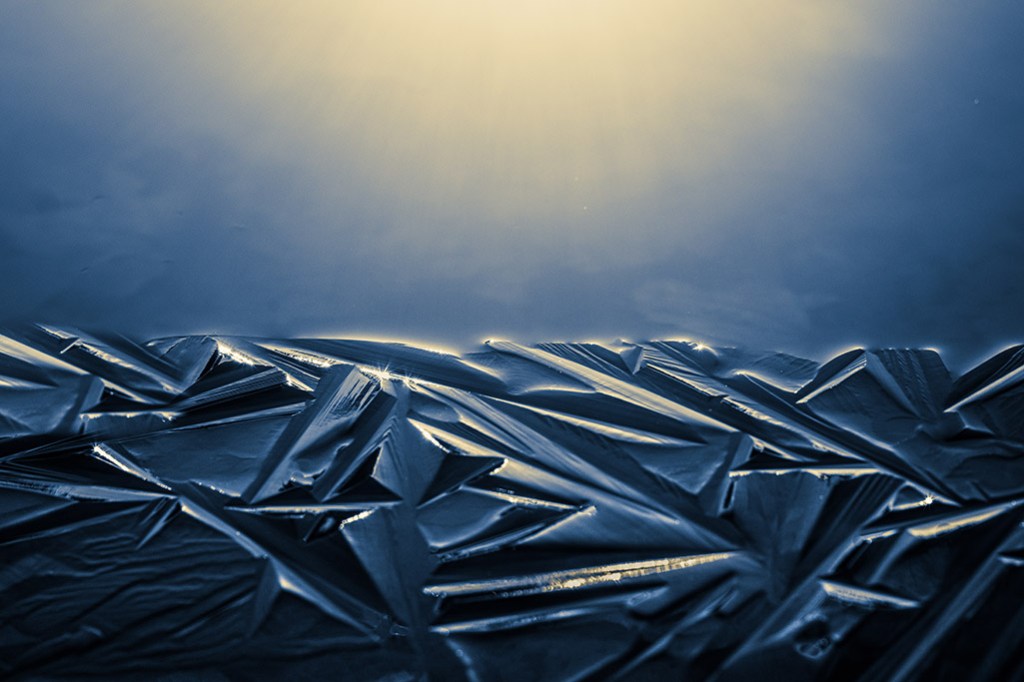
‘The earliest signs of a changing season are captivating to me. By mid-November, nights become bitingly cold. At morning’s light, I visited a pond in Vermont to find the first ice of the season. For me, this scene is thrilling beyond words. Seeing the physical change of water into a striking geometric marvel is an experience that makes me appreciate the glories of life.’
Top tips:
- Pass over the obvious compositions and look for quiet moments that tell a story.
- Be patient. Give yourself time to see deeply and you’ll soon find satisfying compositions.
- Pour your critic a cup of coffee and lock him in the house.
Finalist: Gabi Swart, You See Better With Four Eyes
Nationality: German
Occupation: Retired geologist
Website: gabi-swart-naturfotografie.de Instagram: swartgabi
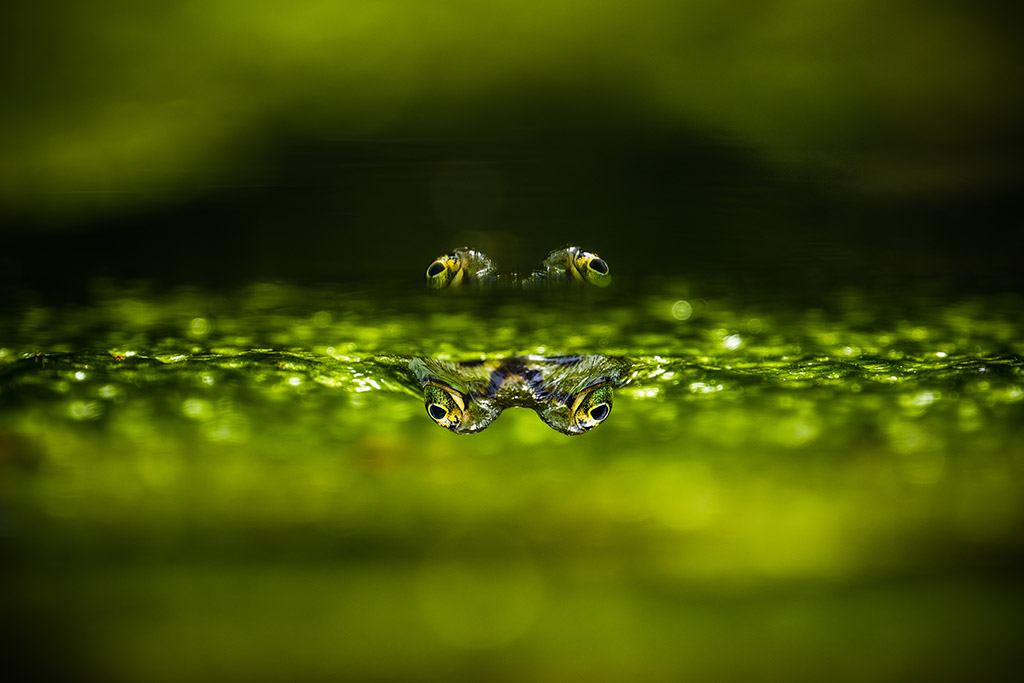
‘This picture was taken in a pond near Ladenburg, Germany. It was shot from a low angle so that the reflection of the frog’s eyes are just visible. I then decided to turn it upside down to confuse the viewer and encourage him/her to look more closely.’
Top tips:
- Adopting a low viewpoint and getting down to an animal’s eye level can result in dramatic pictures.
- Slightly underexposing a picture can make colours appear more saturated and prevent blown highlights.
- The period just before sunset can provide ideal light conditions for images like this one.
Finalist: Alexis Tinker-Tsavalas, Moss Springtail
Nationality: Greek / Canadian
Instagram: @naturefold,
YouTube @naturefold
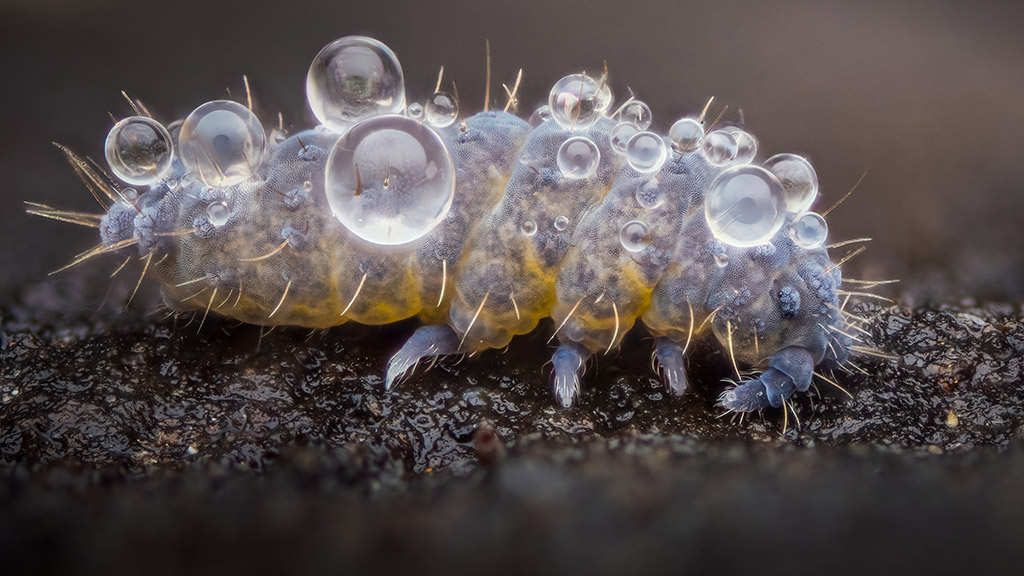
‘While searching for macro subjects on dead wood in winter I came across this springtail (Neanura muscorum) covered in dew droplets. Normally this species is quite active, which makes focus stacking almost impossible, but this individual stayed quite still, giving me the opportunity to get a high-magnification focus stack. I used Zerene Stacker to combine the frames, and sharpened the final image with Topaz DeNoise AI.’
Top tips:
- It can be challenging to find macro subjects in winter, but I always find small arthropods, including springtails, in dead wood on the forest floor.
- If you have a photo with flat lighting, try using masks while editing to add drama. Darken a linear gradient coming from a bottom corner and brighten a linear gradient from the opposite top corner.
- Use a flash and diffuser for smooth, consistent lighting in macro photography.
Finalist: Sandra Stalker, Plastic Sailors
Nationality: British
Occupation: Art technician
Instagram: @teenytinyunderwaterphotos

‘Hundreds of items covered in gooseneck barnacles wash up on Chesil Beach, in the UK, every year, carried there by winter storms. These are non-native to the UK and have usually travelled across the Atlantic. This particular item was a plastic bottle with a colony of goose barnacles and some fishing net I found on the beach.
To tell the story of ocean litter becoming a habitat for wildlife, I took them to the sheltered side of Chesil in Portland harbour and re-floated them there. The water was about 8°C, I was in a wetsuit and the water was incredibly choppy from the wind, which kept blowing the bottle away from me. I shot upwards as I loved the reflection on the surface of the water, while keeping the bottle and barnacles as the main focus of the image.’
Top tips:
- Try to find the calmest water spot with the best visibility possible.
- Owing to the object moving, shoot wider than you want to so that you can crop in post-processing and not chop off crucial parts of the scene.
- Use strobes below the water line to add light to your subject.
Finalist: Claudia Gaupp, Sparkling Crown
Nationality: German
Occupation: Architect
Instagram: @lostinblooms
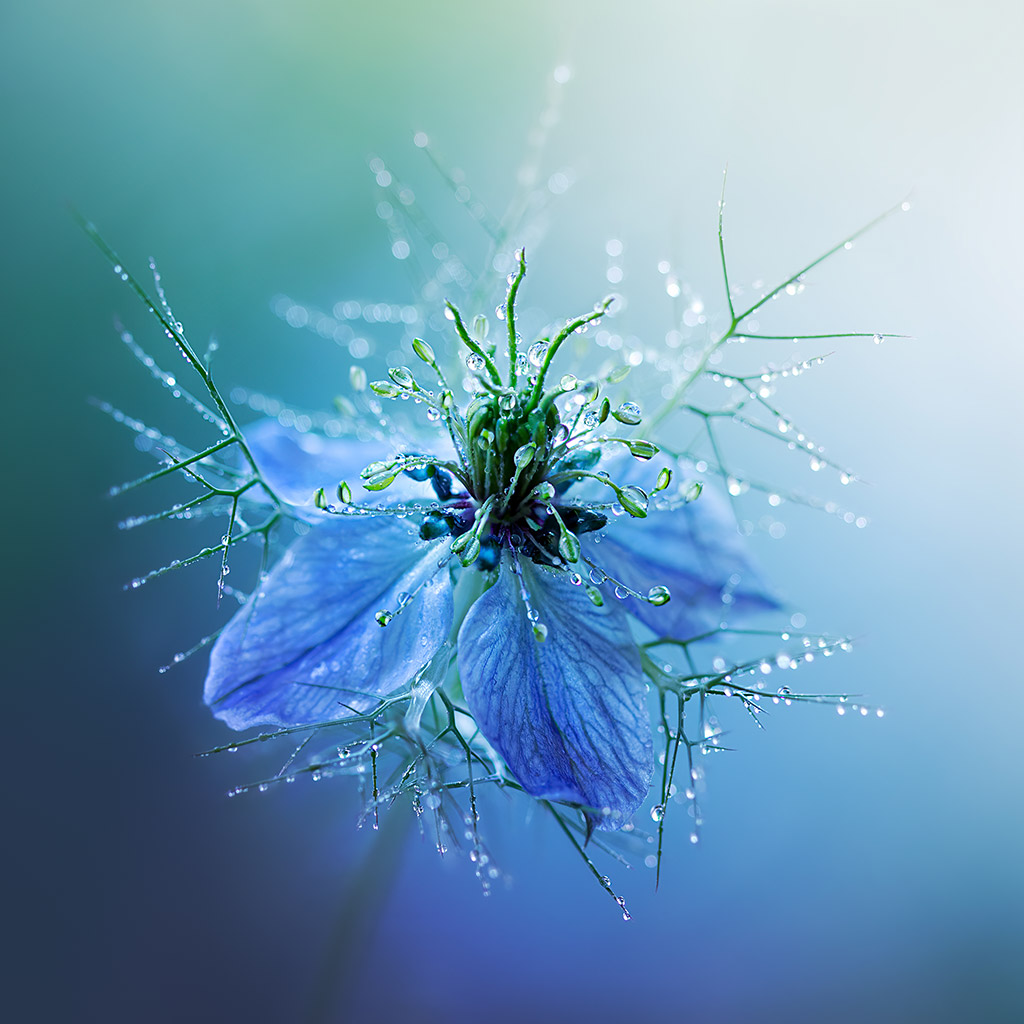
‘Love-in-the-Mist (Nigella damascena) is the epitome of early summer for me. I have always been fascinated by the variety of nigella flowers. From the bud to the dried seed capsule – each phase holds its own secret. In this case I was intrigued by the details of the stamens and petals, which are surrounded by net-like leaves. Shortly after a rain shower, the tiny drops of water caught in the leaves made me think of a sparkling crown on the bloom.
I took the picture in my garden in natural evening light and then converted it in post-processing to a very cool blue-green background in order to match the blue of the flower.’
Top tips:
- Work with a shallow depth of field to achieve a soft and interesting bokeh. Look for colours in the background that match the main subject in an interesting way.
- When taking flower photos, look for ways to highlight details. In this case, the raindrops are the secret star of the composition.
- Knowing the environment you are taking pictures in will help you to go out in the best lighting conditions for your story. I prefer the late evening light in my garden.
Finalist: Barry Webb, Slime Moulds and Raindrops
Nationality: British
Occupation: Gardener / photographer
Website: www.barrywebbimages.co.uk Instagram: @barrywebbimages

‘Following overnight rain, I came across a colony of 2mm tall Physarum album slime mould fruiting bodies on a short section of beech branch, lying in leaf litter on the woodland floor. On closer inspection, I spotted this group encased in raindrops. Carefully positioning the branch in a suitable position, taking care not to disturb the droplets, I shot 101 focus-bracketed images to capture the full depth of the subjects. The resulting images were focus-
stacked using Zerene Stacker software.’
Top tips:
- Shooting after rain or in fog can add an extra dimension to macro subjects.
- Avoid direct sunlight when shooting wet subjects.
- Be very careful handling subjects with waterdrops as they are easily dislodged.
Finalist: Tony North, Milking Bonnets
Nationality: British
Occupation: Workshop teacher
Website: www.artofmacro.com, Instagram: tnorth67, Facebook: tony.north3, Flickr: tonynorth1
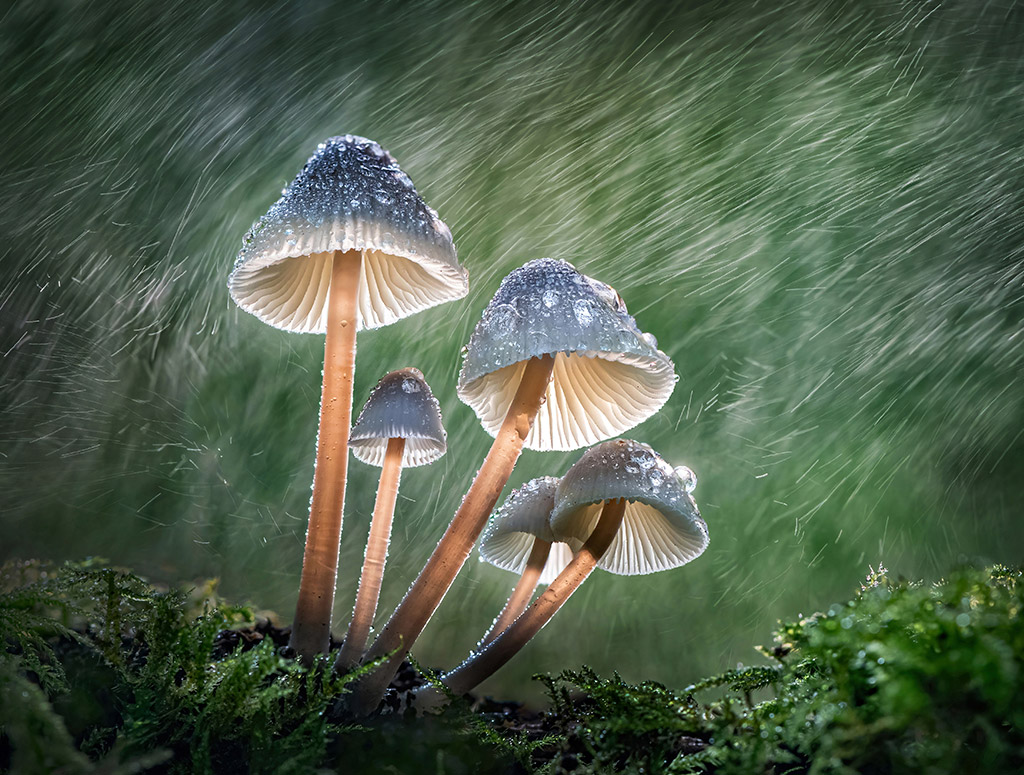
‘I found this clump of mushrooms with an almost perfect shape and number in Marbury Country Park, UK. I lit the scene from behind with an LED panel, both to fill the bonnets with light and to illuminate the droplets, which I created with a fine mist spray. My aim was to enhance the natural beauty of the fungi by adding more light and atmosphere. I focus-bracketed 40 frames of the bonnets, then took one shot with the fungi and the “rain”. I combined the files later in Photoshop.’
Top tips:
- Spend time looking for fungus specimens in good condition. Some species are more attractive than others!
- Find an isolated specimen so it stands out nicely from the background.
- Shoot from low down to catch the details of the gills – this is an attractive feature of mushrooms.
Finalist: Marco Maggesi, Periscope
Nationality: Italian
Occupation: Photographer
Website: www.zamenis.it Instagram: @marco_maggesi
Facebook: @Marco Maggesi
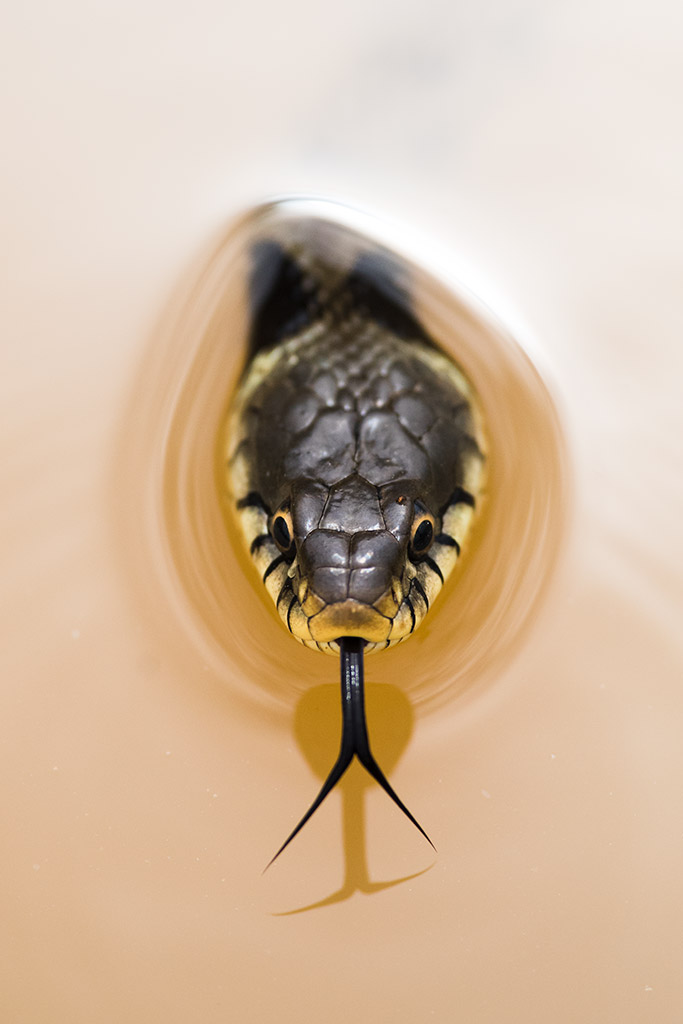
‘This beautiful snake was looking for prey in a pond. I was really lucky because it stopped right in front of me to taste the air. The light was very soft because it was a cloudy day. I used a 300mm lens to capture this portrait. I will never forget this encounter.’
Top tips:
- Shoot fast to freeze any movement. Focus on the eyes.
- Move calmly and slowly so as not to startle the animal.
- Use a long focal length to minimise any disturbance.
Finalist: Pete Burford, Long Over Dew
Nationality: British
Instagram: pbmacro, Facebook: pbmacro, Twitter: pbmacro,
YouTube: pbmacro

‘At Mousecroft pool, Shrewsbury, I photographed this damselfly covered in dew during the early morning hours, at around 3am, in May. Given that insects are cold-blooded and need warmth to move, they typically rest at night. The sudden drop in temperature causes dew to cling to them. This moment is ideal for portraits as they cannot move or fly. As they warm up with the rising sun in the morning, they wipe away the moisture and fly off. To enhance the visual appeal, I used a coloured background card to add contrast and additional hues to the image. Afterwards, I stacked the frames in Helicon Focus, edited in Lightroom and Photoshop and then finished off with Topaz DeNoise.’
Top tips:
- Visit locations late at night to find roosting insects.
- If the background is cluttered or unattractive, try placing a piece of coloured card behind the subject.
- When you’re focus stacking, hold your breath to create more stability and accuracy.
Finalist: Harald Cederlund, Last Flight
Nationality: Swedish
Occupation: Researcher
Instagram: @haraldcederlund
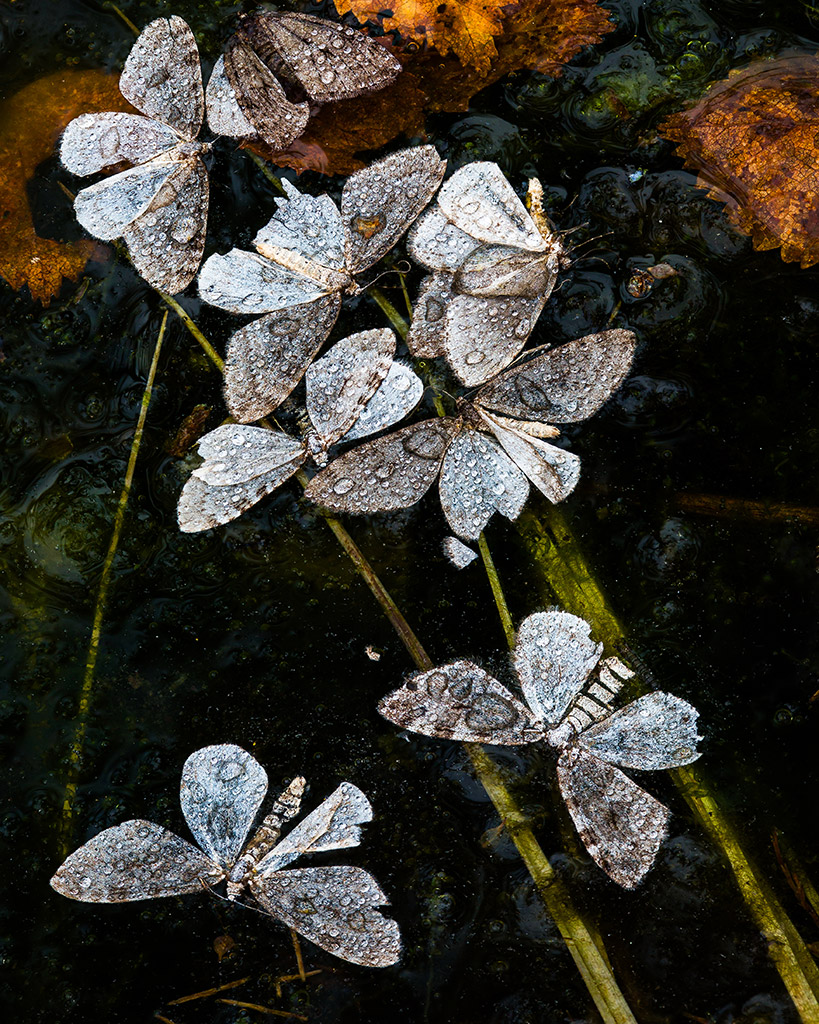
‘In early autumn, large quantities of moths were swarming in the mountain birch forest of Grövelsjön, Sweden – giving the hike through it a certain dream-like quality. My hiking buddy wasn’t feeling great, so we had to stay and rest in a mountain station, allowing me time to explore the immediate surroundings with my camera.
I followed the trail down to Linnés källa – a spring that was supposedly discovered by the botanist Carl Linnaeus. Its surface was littered with large quantities of dead moths, along with some autumn leaves, grasses and algae. It looked to me as if the moths were still dancing over a meadow somewhere, taking one last flight. Later on, I combined five frames in Zerene Stacker to give a greater depth of field.’
Top tips:
- Devote some time to wandering around aimlessly but be prepared to react quickly if you happen to stumble across something interesting.
- Take some backup shots to be safe. (Most of the exposures I took on this occasion were a bit blurry owing to the poor lighting conditions and the difficulties of balancing my tripod on the edge of the spring.)
- Consider focus stacking to maximise depth of field.
More news:
- How to win APOY from winner Daniel Sands
- Taylor Wessing Photo Portrait Prize open for entries!
- Pink Lady Food Photographer of the Year 2024 shortlist lands
Follow AP on Facebook, Twitter, Instagram, YouTube and TikTok.

